Video of the Week:
Harvesting Lettuce
Upcoming Events
June 11 & 12
Haysville/Belle Plain, KS
For more information, go to http://www.hfrr.ksu.edu/doc4298.ashx
KSU Bedding Plant Field Day
July 21
K-State Research & Extension Center, Olathe
K-State Research & Extension Center Open House
July 25
Olathe
Kansas Turf & Ornamentals Field Day
August 6
K-State Research & Extension Center, Olathe
For more information, go to TurfFieldDay
Vegetables:
Mulching Tomatoes
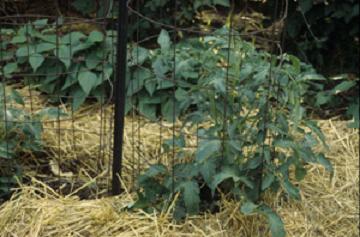
Hay and straw mulches are very popular for tomatoes but may contain weed or volunteer grain seeds. Grass clippings can also be used but should be applied as a relatively thin layer – only 2 to 3 inches thick. Clippings should also be dry as wet clipping can mold and become so hard that water can’t pass through. Also, do not use clippings from lawns that have been treated with a weed killer until some time has passed. With most types of weed killers, clippings from the fourth mowing after treatment may be used. If the lawn was treated with a product containing quinclorac (Drive), the clippings should not be used as mulch. If the weed killer used has a crabgrass killer, it likely contains quinclorac. (Ward Upham)
Turfgrass:
Controlling Yellow Nutsedge in Lawns
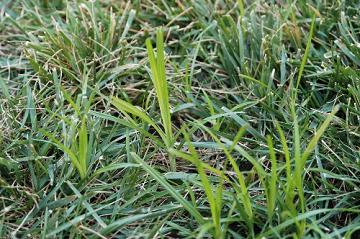
Nutsedge is difficult to control culturally because it produces numerous tubers that give rise to new plants. Pulling nutsedge will increase the number of plants because dormant tubers are activated. However, it is possible to control nutsedge by pulling, but you must be persistent. If you are, eventually the nutsedge will die out.
If you were going to treat with an herbicide, it would be better to leave the nutsedge plants undisturbed so the herbicide can be maximally translocated to the roots, rhizomes, and tubers. Several herbicides are available for nutsedge control. Sedge Hammer, which used to be called Manage, is the most effective and safe for most turfgrasses. It is also the most expensive, but if an infestation is not too severe, one application should take care of the problem. The Sedge Hammer label says to apply it after nutsedge has reached the three- to eight-leaf stage. Waiting until this growth stage apparently results in improved translocation of the active ingredient to the underground tubers and rhizomes. However, research has shown that the application should go down by June 21. If the initial spray is after June 21, mature daughter tubers may be stimulated to grow.
Small packages of Sedge Hammer are available to homeowners. Using a non-ionic surfactant with the Sedge Hammer will give better control. (Ward Upham)
Recent Rains Trigger Mushroom Development
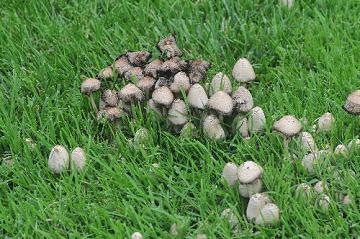
Unfortunately, the thick fungal mat formed by the fungus interferes with water infiltration. The fungus also may release certain byproducts that are toxic to the turf. This can lead to dieback of the turf close to the ring. Fairy rings are difficult to control. You can sometimes eliminate the ring by digging to a depth of 6 to 12 inches and 12 inches wide on both sides of the ring, refilling the hole with non-infested soil. Or you can try to mask the symptoms by fertilizing the rest of the lawn so that it is as dark green as the ring. This often isn't a good idea because it tends to promote other turf problems. Commercial people can use certain fungicides to control fairy rings but these products are not available to homeowners. See http://www.ksre.ksu.edu/bookstore/pubs/EP155.pdf for more info on these fungicides.
Some mushrooms in lawns are not associated with fairy rings. These may be mycorrhizal (symbiotic association with tree roots) or saprophytic (live on dead organic matter such as wood, etc.) in the soil. Because some of these mushrooms are beneficial, you don't really want to kill them. Besides, a fungicide spray to the mushroom itself does little good. Remember the mushroom is simply the fruiting structure of the organism. Most of the fungus is below ground and inaccessible to the chemical. If mushrooms are a nuisance, pick them and dispose of them as soon as they appear. Remove sources of large organic debris from the soil. Also, mushrooms tend to go away as soil dries. Patience may be the best control. Some of the mushrooms in the lawn are edible, but others are poisonous. Never eat mushrooms unless you are sure of their identity. (Ward Upham)
Control of Prostrate Spurge
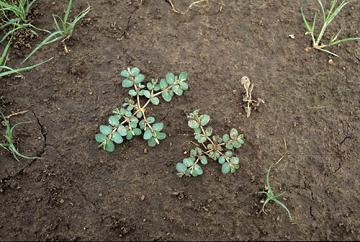
Several years ago K-State Research and Extension conducted a study on the phytotoxic effects of certain herbicides on buffalograss. During the application, we noted the presence of a large number of small prostrate spurge plants. As the study progressed, plots were rated for percent control of spurge. The results were interesting. We found that Drive (quinclorac) provided more than 90 percent control. Until recently, Drive was only available to commercial applicators. Now homeowners have additional products that contain Drive. Those products are listed below.
Ortho Weed-B-Gon Max + Crabgrass Control
Bayer All-in-One Lawn Weed and Crabgrass Killer.
Drive in Monterey Lawn and Garden Fertilome Weed Out with Q
Trimec Crabgrass Plus Lawn Weed Killer
Bonide Weed Beater Plus Crabgrass & Broadleaf Weed Killer
Spectracide Weed Stop for Lawns Plus Crabgrass Killer
If you choose to use any of the above products, do not compost clippings or use them as mulch. The quinclorac can harm certain broadleaf plants. Clippings should be returned to the lawn or discarded.
Dimension and Turflon Ester offered more than 80 percent control, and Trimec 78 percent. Dimension results were surprising because it is a preemergence herbicide with some postemergence activity that is commonly used for crabgrass control. Turflon Ester should only be used on cool-season grass such as tall fescue and Kentucky bluegrass; not on warm-season grasses such as bermuda, zoysia or buffalo. Remember that these are very small, immature spurge plants. Larger, more mature plants are much more difficult to control. (Ward Upham)
Fruit:
Fireblight on Apple and Pear
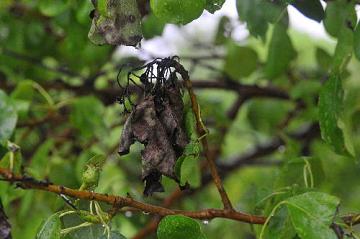
During the summer, prune out the blighted tips during dry weather. Make your pruning cut 10 to 12 inches below the discolored area of the branch. Disinfect pruning equipment between cuts with a 10 percent bleach solution, rubbing alcohol or some other disinfecting agent. If using bleach, be sure to clean and oil equipment after use because bleach is corrosive. Some people prefer the ugly stub method and snap the branch off below the blighted area. This helps someone see at a glance where fireblight occurred in the tree and will facilitate follow-up pruning during the winter. (Ward Upham)
Ornamentals:
Vein Pocket Galls on Oak
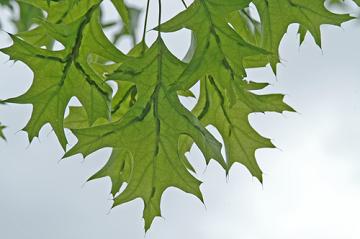
Generally, these gall insects do not cause significant damage to their hosts, though some of the leaf galls can cause enough deformity to make a tree unsightly. Also, severe infestations of twig galls can cause twig dieback or, rarely, tree death. However, just because a twig is covered with galls does not mean it is dead. I have seen twigs that looked like a solid mass of galls leaf out in the spring.
Insecticide sprays applied when galls are noticed are ineffective because damage has already occurred. Also, larvae are unaffected because of the protection afforded by the gall. Insecticide sprays can kill emerging adult wasps and flies, but long emergence periods and short residuals of most contact insecticides make this impractical. Stem and twig galls can be pruned if this is deemed to be practical and necessary. Fortunately, natural predators and parasites usually bring these insects under control given a year or two. Therefore, the best option is usually to do nothing. (Ward Upham)
Flowers:
Iris Bacterial Soft Rot
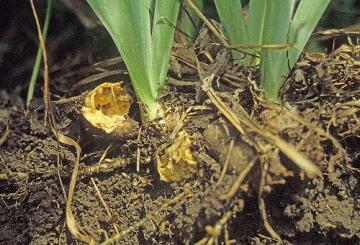
Though most often associated with iris borer, environmental damage can also provide an entry point for this disease.
Rhizomes that show extensive signs of damage should be discarded. If there is a plant that has special value, you may wish to try to save it. The American Iris Society suggests using a spoon to remove all infected tissue. Then, allow the rhizome to dry in the sun. Finally, use a chlorine based cleanser to powder the wound. Dousing in place with Dial antibacterial soap (with triclosan) can be substituted for the chlorine based cleanser.
When dividing rhizomes from beds that have shown evidence of soft rot, disinfect the knife between cuts of even apparently healthy rhizomes with a 10% bleach solution or rubbing alcohol.
As mentioned previously, iris borer damage can provide a place of entry for this disease. To control iris borers, remove and discard dead leaves in the fall to eliminate a number of the iris borer eggs. Larvae can also be killed by hand in June by squeezing infested leaves in the vicinity of the injury. During division, borers in lightly infested rhizomes can be killed by poking them with a piece of wire. Borer control can also be achieved through the use of imidacloprid (Merit, Bayer All-In-One Rose & Flower Care, Bonide Systemic Granules, Hi-Yield Systemic Insect Granules) or through the use of the parasitic nematodes Steinernema carpocapsae or Heterorhabditis bacteriophora.
Imidacloprid should be used as a drench (directions on label) when the air temperature reaches 70 degrees two days in a row.
The parasitic nematodes must be applied when the soil temperature is above 50 degrees F. Use 1 quart water/nematode mix per square foot to allow the nematodes to swim to the pest. Steinernema carpocapsae gave better control (100%) than Heterorhabditis bacteriophora (87%) in research conducted by the University of Maryland. (Ward Upham)
Contributors: Ward Upham, Extension Associate
 RSS Feed
RSS Feed
